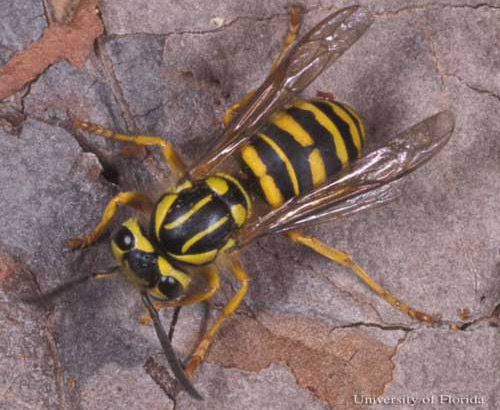
by Matt Lollar | Sep 1, 2021
Last week I was trimming shrubs around my house and I had the wild idea to pull up a couple yaupon holly saplings around the base of a live oak tree…without looking. As I was pulling up one of the saplings I felt a piercing sting on my ankle. I yelled some obscenities and ran away as quickly as I could, but it was no use. By the time I got far enough away, I had been stung eleven times and I still had a few yellowjackets flying around in my shorts.

Southern yellowjackets create underground colonies that can hold over 2,000 yellowjackets. Photo Credit: UF/IFAS
Two species of yellowjackets can be found in Florida along with a similar species known as the baldfaced hornet. The eastern yellowjacket (Vespula maculifrons) is found in eastern North America and the southern yellowjacket (Vespula squamosa) is found in the eastern United States, Mexico, and Central America.
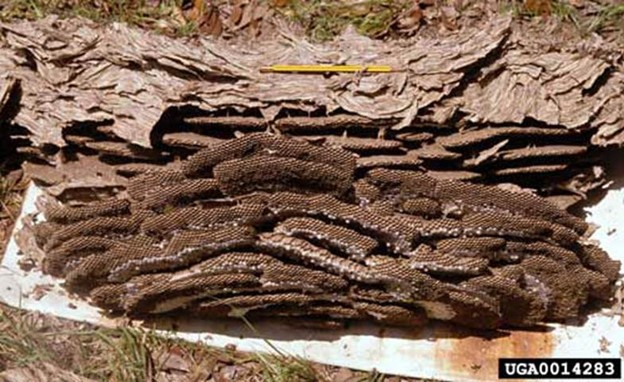
Southern yellowjacket, Vespula squamosa (Drury), nest dug from ground.
Credit: Gerald J. Lenhard; http://www.insectimages.org/
Yellowjacket colonies are started in the spring by a single queen that mated in the fall and overwintered. Yellowjacket nests consist of a series of horizontal combs that may be above ground, underground, or both. The queen builds the initial nest and forages for food on her own. Her offspring then assume all jobs except for laying eggs. In the fall, larger cells are built for a new batch of queens. The new queens then emerge, mate, and seek shelter for the winter. The old queen dies and the remaining colony breaks down.
Yellowjackets aren’t all bad, they provide a great service to our gardens and landscapes by attacking a number of insects that are pests to our crops. However, the moral of this story is to always be aware of what is lurking under your feet and above your head. And maybe yaupon hollies shouldn’t be messed with regardless of their native invasiveness. Nests are less active at night, but any disturbance will trigger an attack. However, it is best to leave nest removal to professionals.
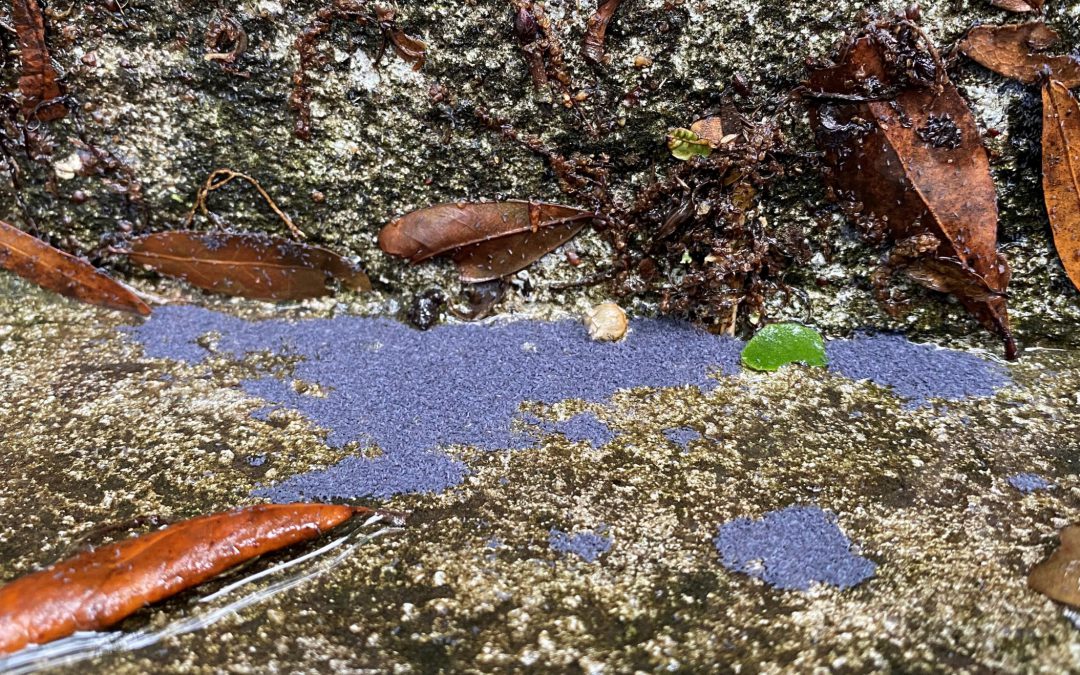
by Matt Lollar | Jun 17, 2021
A month or so ago I was leaving for work and I noticed a strange substance near the entrance to the house. The substance was blue and my first thought was crushed chalk from my kids writing on the sidewalk. Upon closer investigation I realized the substance was moving! It was now clear to me that the substance wasn’t chalk, but a congregation of insects. Naturally, I took pictures and collected a sample to bring into the county extension office…where I work. I looked at the insects under the microscope, but I wasn’t able to determine the species. So I sent some samples off to the University of Florida/IFAS Entomology and Nematology Department and the Florida Department of Agriculture and Consumer Services.
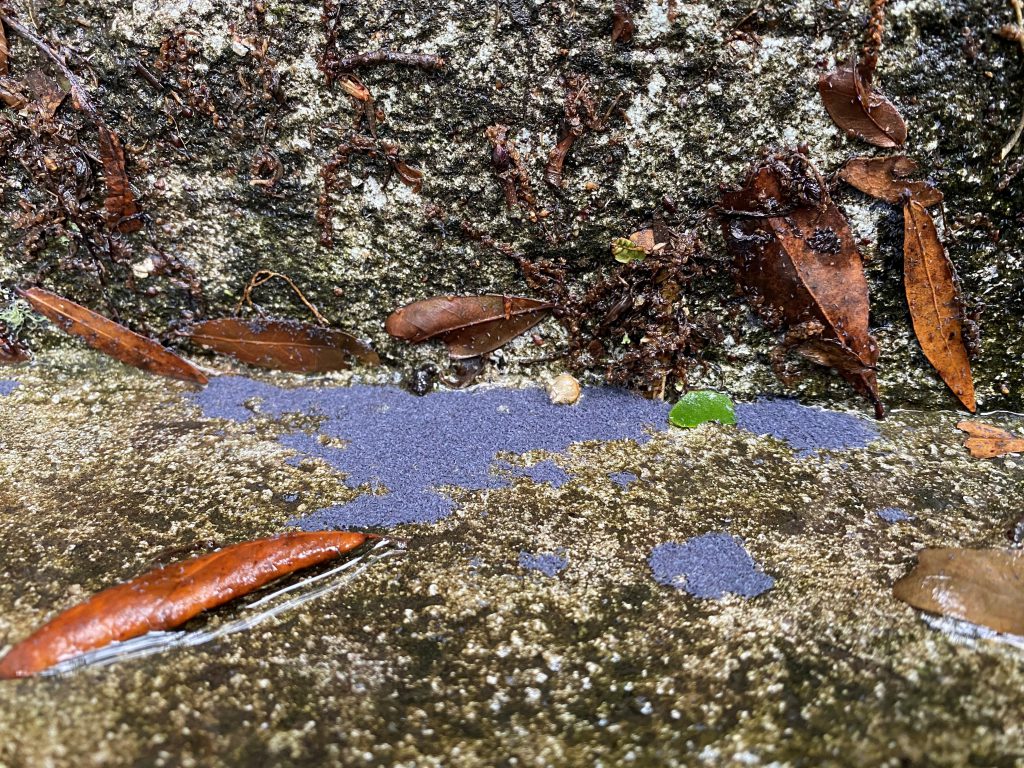
A swarm of Desoria flora on damp, outdoor steps. Photo Credit: Matt Lollar, University of Florida/IFAS Extension – Santa Rosa County
The experts identified the specimens as Desoria flora, a species of springtail insects endemic to Florida and originally described in Alachua County in 1980. Both entomologists thought it was unique the springtails were swarming. Springtails live in leaf litter and upper layers of soils. They are sometimes found in the potting mix of indoor and outdoor plants. Clients bring springtail specimens in to the office for identification from time to time. However, this was the first time I had seen them in a congregation.
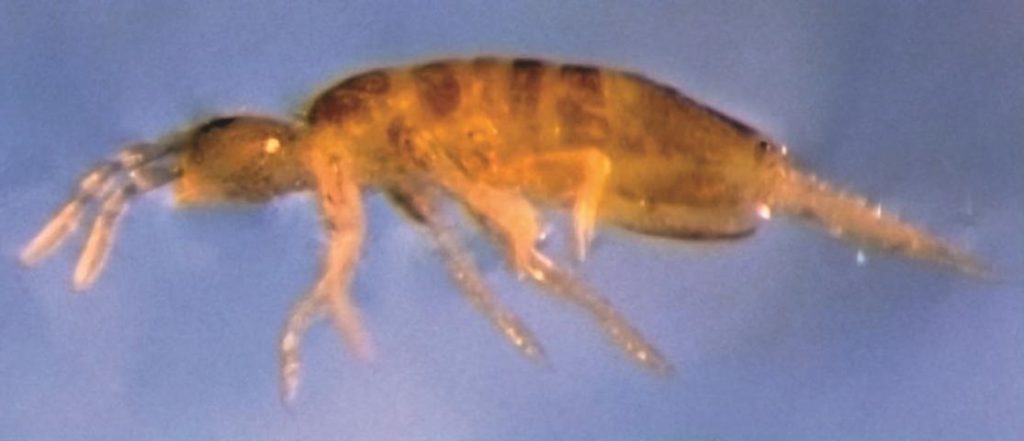
A linear springtail. Photo Credit: University of Florida/IFAS
If you find interesting insects, plants, or fungi and want them identified, please bring them into your local Extension Office. We’d be happy to help you identify the specimens. But sometimes we have to mail things off to a specialist.
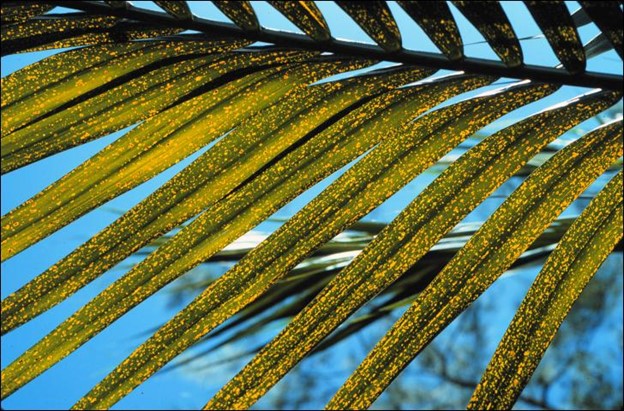
by Matt Lollar | May 13, 2021
Palm trees are great for adding a tropical feel to your landscape. For the most part, they are easy to care for, however there are a number of environmental and nutritional factors that can affect palm tree growth. Extended drought conditions can cause palm trunk to contract or shrivel and extended periods of moisture can cause trunks to swell and crack.
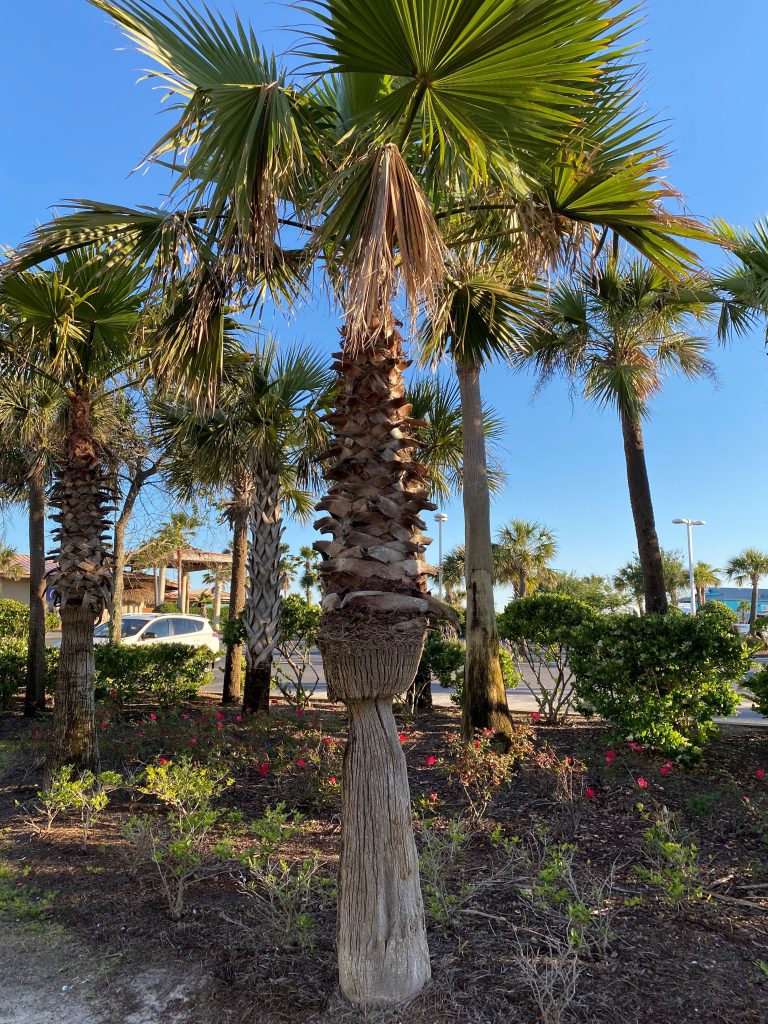
A palm tree with an irregularly shaped trunk due to water stress. Photo Credit: Matt Lollar, University of Florida/IFAS Extension – Santa Rosa County
Palm trees are monocots and do not have lateral meristems or vascular cambium. In dicot and coniferous trees these structures produce additional xylem (water transport structures) internally and phloem (nutrient transport structures) and bark externally. This means that once the apical meristem (frond producing portion of the palm) dies, the tree dies. It also means that wounds to the trunks of palms are visible for life instead of healing over like in dicots. If you were to cut the top out of a red maple, a number of it’s branches would fight to take over as the main trunk. If you were to cut the top out of a palm tree , you would be left with a dead snag for a tree. Palms certainly have unique structures and growing habits. Visit this publication from Dr. Timothy Broschat for more information on palm tree anatomy and morphology.
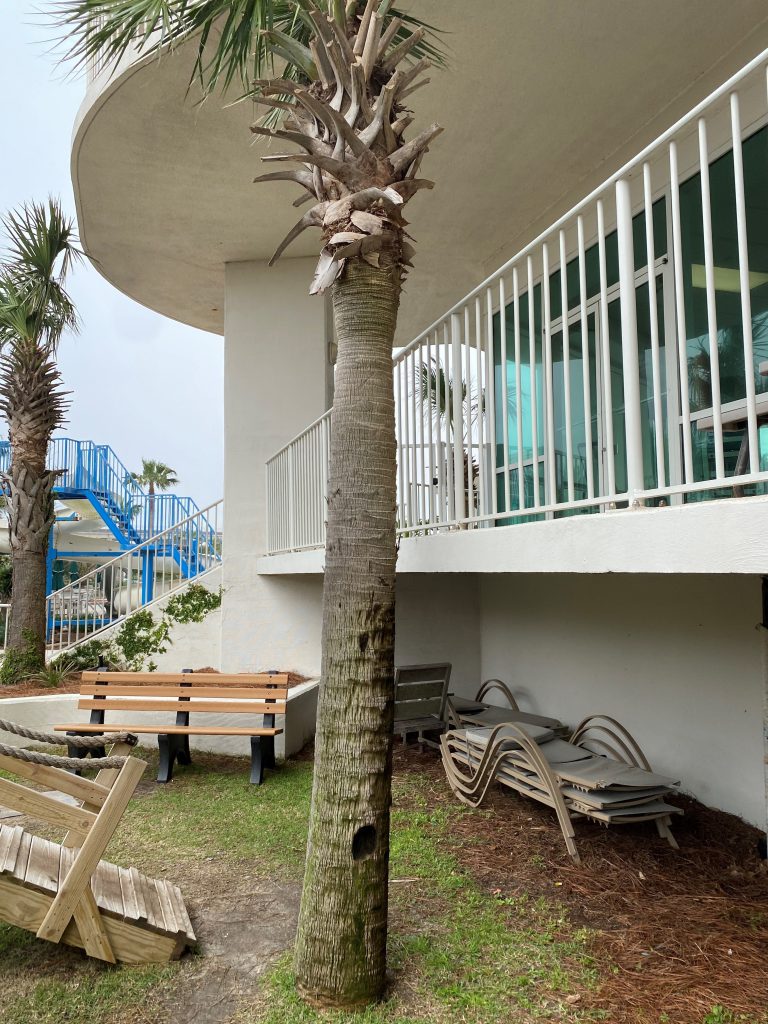
A palm tree with a wound near the base of its trunk. Photo Credit: Matt Lollar, University of Florida/IFAS Extension – Santa Rosa County
Palm trees display nutritional disorders differently from other trees. Their nutritional balance gets disrupted if too much nitrogen is applied. This often happens when high nitrogen turfgrass fertilizers are applied near palm plantings. The recommended palm fertilizer is 8-2-12 (nitrogen-phosphorus-potassium) plus 4 magnesium all available in 100% slow release form. A soil test is recommended to determine if other micronutrients are needed in addition to magnesium.

Potassium-deficient older leaf of Dictyosperma album (hurricane palm) showing translucent yellow-orange spotting. Photo Credit: Timothy K. Broschat, University of Florida/IFAS
Potassium is one of the most common nutrient deficiencies observed in palm trees. For more detailed information on palm tree nutrient deficiencies please visit the publication: Nutrient Deficiencies of Landscape and Field-Grown Palms in Florida.
This article provides just a glimpse of some of the common issues that affect palms. For more information on what could be going on with your palm trees and general palm tree care please visit Ask IFAS: Palm Care.
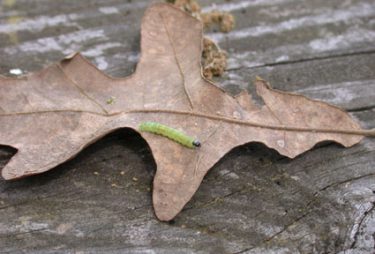
by Matt Lollar | Apr 1, 2021
If you’ve been raking leaves recently, you’ve probably noticed little green worms hanging from the trees. They seem to be in abundance this year and can be found crawling on driveways, just hanging around, and maybe even feeding on oak tree leaves.
These green worms that are all over the yard are oak leafrollers (Archips semiferanus) or oak leaftiers (Croesia semipurpurana). Some people may refer to them as inchworms, however a number of different caterpillars can go by that name. Leafrollers and leaftiers range in length from 1/4″ to 1″. The adult form of these insects is a 1/2″ long moth. The oak leafroller moth is mottled tan and brown and the oak leaftier moth is yellow with brown markings.
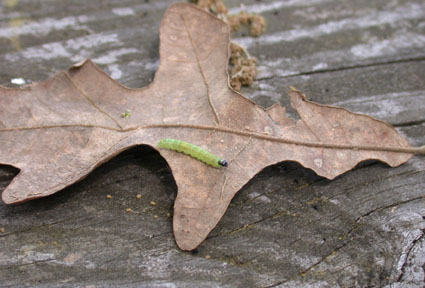
An oak leafroller caterpillar crawling on a leaf. Photo Credit: Blair Fannin, Texas A&M University
In May, the adults of both species lay their eggs in the twigs and leaf buds of a number of tree species. The eggs don’t hatch until March of the following year. When the caterpillars emerge, they feed on the newly forming leaves and flowers of oak, hackberry, pecan and walnut trees. If they are disturbed, they will stop feeding and hang from a strand of silk. Oak leafroller caterpillars pupate in tree branches, while oak leaftier caterpillars drop to the ground and pupate in leaf litter. Adult moths emerge in one to two weeks.
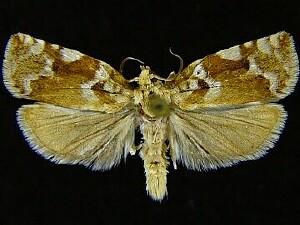
A leafroller moth with wings spread. Photo Credit: U.S. National Museum
The oak leafrollers and oak leaftiers don’t really do enough damage to be considered pests, but they are a bit of a nuisance. Thankfully, birds and parasitic wasps will eat and kill the majority of the population. For in-depth information on most of the interesting insects in your yard, please visit the UF/IFAS Featured Creatures Website.
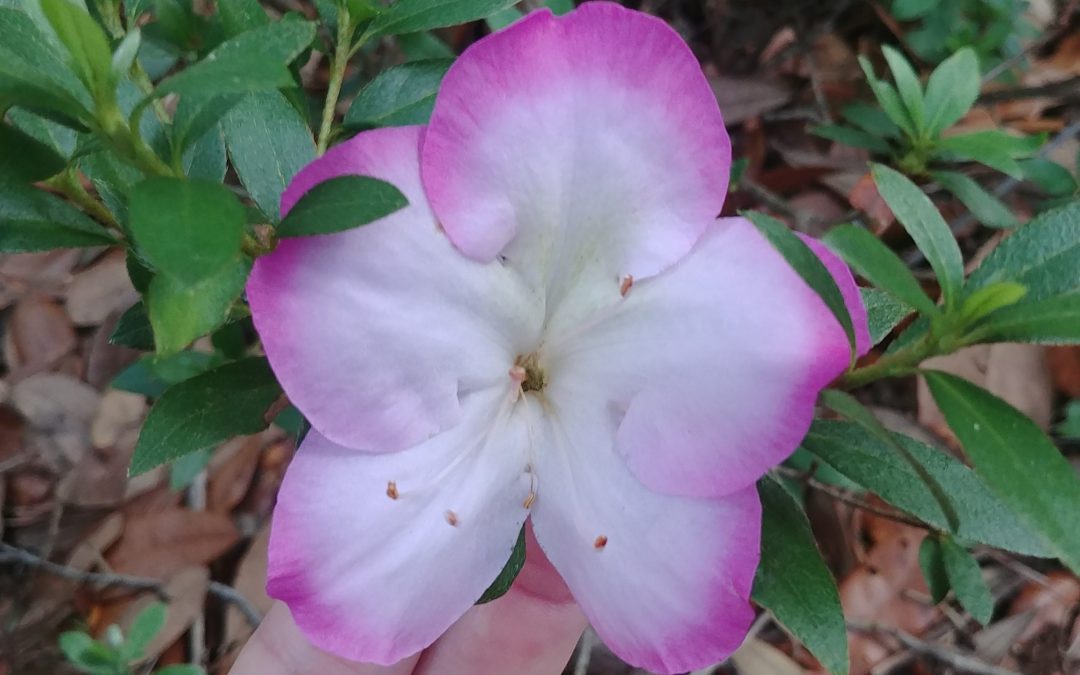
by Matt Lollar | Mar 25, 2021
Article written by Dr. Gary Knox, North Florida Research & Extension Center – Quincy, FL.
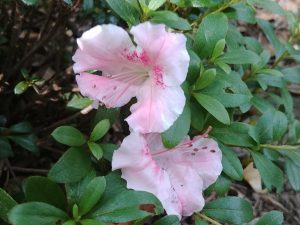
‘Gumpo Pink’ flowers are 3 inches in diameter and are pink with purplish pink dots and occasional white blotches on petals.
Background
In the times before re-blooming azaleas like Encore®, Bloom-A-Thon® and others, Satsuki azaleas were valued for late flowering that extended the azalea “bloom season”. Even with modern re-blooming azaleas, Satsuki azaleas still are appreciated as refined evergreen shrubs for the sophisticated garden or discerning plant collector.
“Satsuki” means “Fifth Month” in Japanese, corresponding to their flowering time in much of Japan. These azaleas were developed hundreds of years ago from their native Rhododendron indicum and R. eriocarpum. The Japanese selected cultivars more for their form and foliage than for flowering. These beloved plants were used in gardens as sheared boxwood-like hedges or pruned into rounded mounds that might resemble rocks or boulders in classical Japanese gardens. Their size and form also made them well adapted for training as bonsai. Most of the Satsuki azaleas in America were introduced in the 1930s by USDA.
Description
Satsuki azaleas are small evergreen shrubs that flower in April and May in north Florida, long after most older type azaleas have finished. Satsuki azaleas also are known for producing large, mostly single flowers up to 5 inches in diameter in colors of white, pink, red, reddish orange and purple. Often the flowers will include stripes, edging, blotches, spots or flecks of contrasting colors (Sometimes all on the same plant!) with more than 20 different color patterns recorded.
Satsuki azaleas have an elegant subtle charm, quite unlike the flashy, over-the-top, heavy blooming all-at-once Southern Indica azaleas like ‘Formosa’ and ‘George L. Taber’. Typically, Satsuki azaleas display a few large blooms at a time, allowing one to better appreciate their size and color patterns as contrasted against their fine-textured, dark green leaves. To make up for a less boisterous display, Satsuki azaleas flower over a longer timeframe, averaging about 8 weeks, with some flowering an amazing 14 weeks. In another contrast, most Satsuki azaleas grow smaller in size, in my experience reaching about 3 feet tall and wide in a five-year timeframe. The rounded to lance-shaped leaves of Satsuki azaleas also are demure, ranging in length from just ½ inch to no more than 2 inches.
Culture
Satsuki azaleas enjoy the same conditions as most other azaleas: light shade and moist, rich, well-drained soil. Mulch regularly to maintain organic matter and help hold moisture. Fertilize lightly and keep the roots evenly moist. Minimal to no pruning is required. Satsuki azaleas also are well adapted to container culture. Their small size and fine textured leaves make these a favorite for bonsai enthusiasts since their small leaves, branching habit and mounded form naturally make them look like miniature mature “trees”.
Sources and Cultivars
Look for Satsuki azaleas in spring at garden centers or year-round at online nurseries. There are hundreds of cultivars but some popular types to look for include:
Gumpo Pink – 3-in. diameter light pink flowers with purplish pink dots and occasional white blotches
Gumpo White – 3-in. diameter white flowers with occasional pink flakes and light green blotches
Gyokushin – 3-in. diameter flowers are predominantly white but with light to dark pink dots and blotches
Higasa – flowers are 4 to 5 inches in diameter and are purplish pink with purple blotches
Shugetsu – also called ‘Autumn Moon’, 3-in. diameter flowers are white with a broad, bright purplish-red border
Tama No Hada – flowers are 4 to 5 inches in diameter and are white to pink with deep pink stripes; usually flowers in fall as well as spring
Wakaebisu – 2.5-in. diameter flowers are “double” (hose-in-hose) and are salmon pink with deep pink dots and blotches; this also flowers in fall as well as spring
References:
Chappell, M. G.M. Weaver, B. Jernigan, and M. McCorkle. 2018. Container trial of 150 azalea (Rhododendron spp.) cultivars to assess insect tolerance and bloom characteristics in a production environment. HortScience 53(9-S): S465.
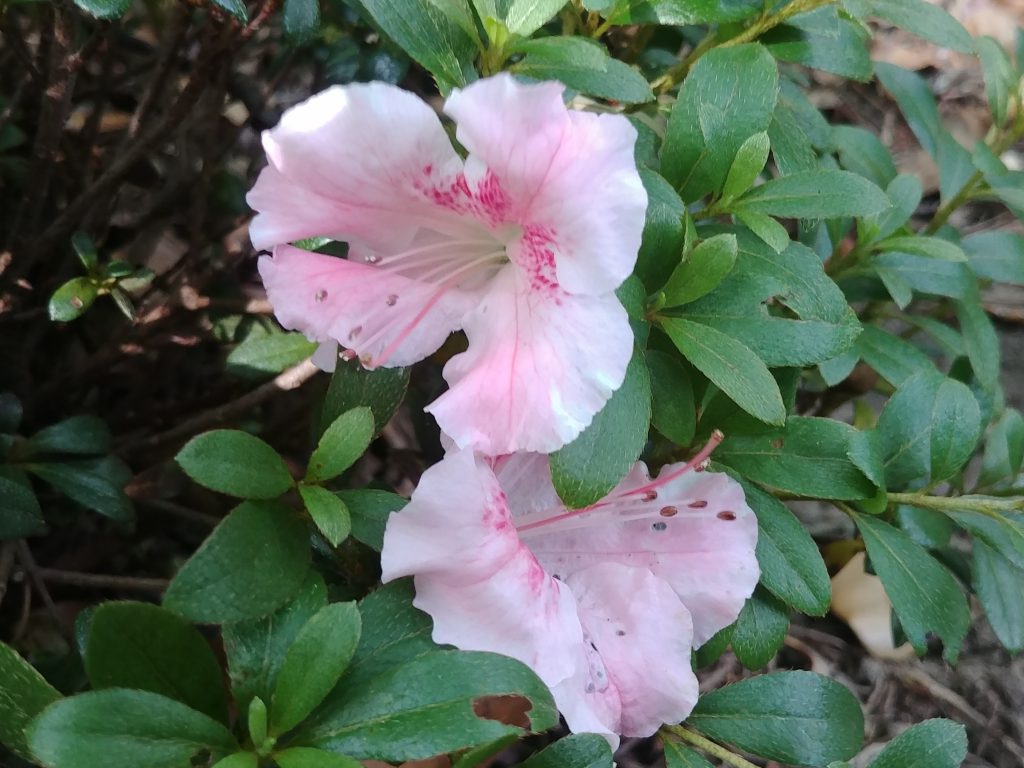
‘Gumpo Pink’ flowers are 3 inches in diameter and are pink with purplish pink dots and occasional white blotches on petals.
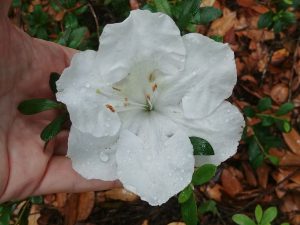
‘Gyokushin’ flowers are white with occasional pink flecks and light green blotches.
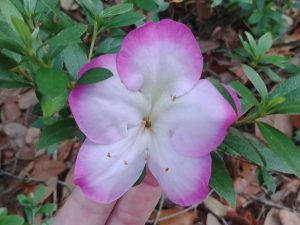
‘Shugetsu’ has 3-inch flowers that have bright purplish-red border on edges of petals.
Galle, Fred C. Azaleas. 1985. Timber Press, Portland, Oregon. 486 pp.

















